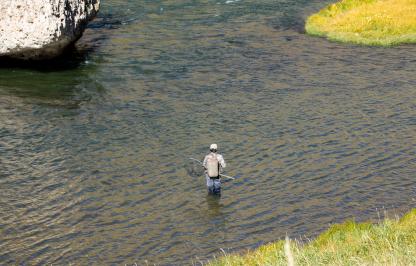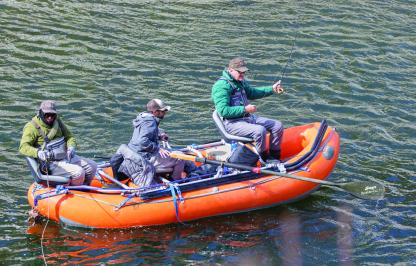Public asked to watch for rusty crayfish in Laramie River watershed
LARAMIE – Anglers, crayfish trappers, and other outdoor recreationists are asked to help the Wyoming Game and Fish Department protect our outstanding fisheries by reporting any rusty crayfish found in the Laramie River watershed.
Rusty crayfish (Orconectes rusticus) are native to the Ohio River Basin, but have invaded many other states and Canadian provinces. They were first discovered in Wyoming in 2006 after being illegally introduced into private ponds and then escaping into Wagonhound Creek, a tributary of the North Platte River. Despite the Game and Fish Department’s early eradication efforts, the species has recently been found in the Laramie River as a result of another illegal introduction.
Rusty crayfish are 3-5 inches long, with a grayish-green body and easily-identifiable reddish fingerprint-like spots on each side of the body just in front of the tail. “The rusty red spots look as if someone picked up the crayfish and squeezed it,” said Bobby Compton, Fisheries Supervisor for the Game and Fish Department’s Laramie Region. The claws have orange tips with a black band immediately behind the orange.
Rusty crayfish can cause a variety of negative environmental and economic impacts when introduced. They displace native crayfish species, reduce the amount and types of aquatic plants and invertebrates, and may reduce some fish populations. They may also reduce the quality and quantity of habitat available to native species, such as the hornyhead chub, a rare species found only in the Laramie River drainage. Rusty crayfish feed on a variety of aquatic plants and benthic invertebrates, such as aquatic worms, snails, leeches, clams, and crustaceans. They also feed heavily on mayflies, stoneflies, and other invertebrates that are important food sources to stream fishes.
“Rusty crayfish are very aggressive and very prolific. If this species expands in our waters we could potentially see a loss of our native crayfish species and severe impacts to other aquatic species,” Compton said. “No Wyoming water should have this species. Their purposeful introduction was unethical and they may destroy the top-notch waters we all love. The extent of the rusty crayfish infestation is not completely known at this time.”
Rusty crayfish prefer areas that offer rocks, logs, or other debris as cover. They inhabit both pools and fast water areas in lakes or streams that provide suitable water quality. Mature rusty crayfish mate in late summer, early fall, or early spring. The male transfers sperm to the female, which she then stores until her eggs are ready to fertilize. Because of the females’ ability to store sperm, even the release of a single female could establish a new population. Once populations are established, it is very challenging and in most cases impossible to eradicate them. “The rate of spread in the Laramie River watershed is slow, but they are spreading. We are just beginning to learn this story,” Compton said.
Landowners who are considering developing fishing ponds should be aware of the problems with introducing these types of invasive species and should ask consultants a lot of questions before hiring them. “Ask contractors if they have the proper permits to deal in the species they supply, ask to see the permits, and look at the fish that are being stocked,” Compton said. Landowners should be aware that Wyoming Game and Fish Commission Regulations prohibit the possession or importation of rusty crayfish. Chapter 10 states, “Crustaceans and mollusks shall not be imported into the State for release into the waters of the state or for use as live bait.”
The key to preventing the spread of rusty crayfish is to stop moving them into new waters. Anglers and crayfish trappers can help by never moving live crayfish, and reporting any rusty crayfish they find. “Reporting invasive species is a responsibility for all ethical outdoor enthusiasts,” Compton said. He reminds sportsmen that it is illegal to move rusty crayfish, whether dead or alive.
“If you find a rusty crayfish, or catch one in a trap, take a photo of it and either return it to the water or kill it; the easiest way to kill them is to break them in half,” he said. Then contact the Laramie Game and Fish Department at (307) 745-4046 or reportais@wyo.gov. Wyoming Game and Fish Regulations require mandatory reporting within 48 hours of discovering an invasive species. Fines up to $10,000 are possible for knowingly possessing aquatic invasive species.
Public asked to watch for rusty crayfish in Laramie River watershed


